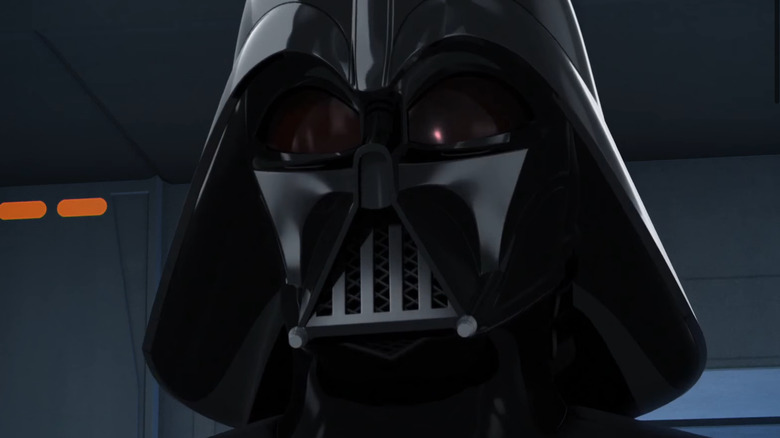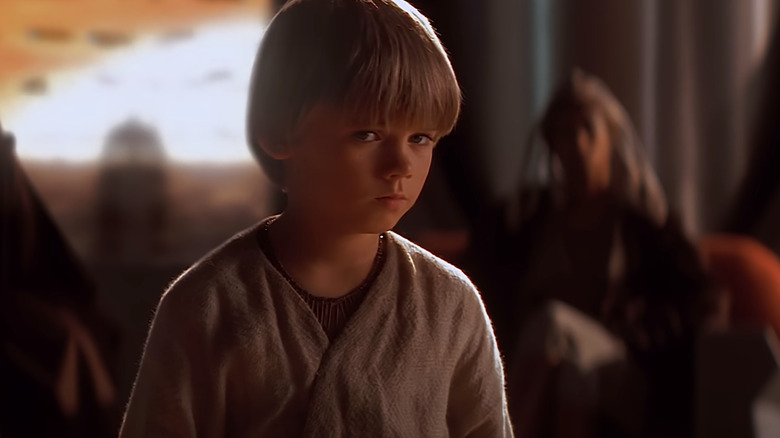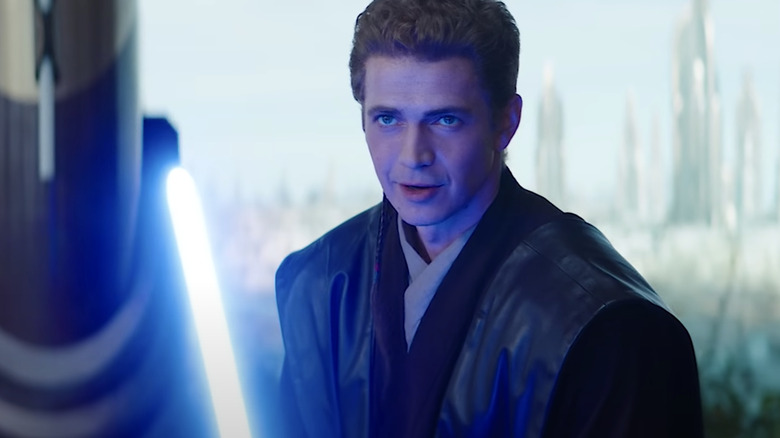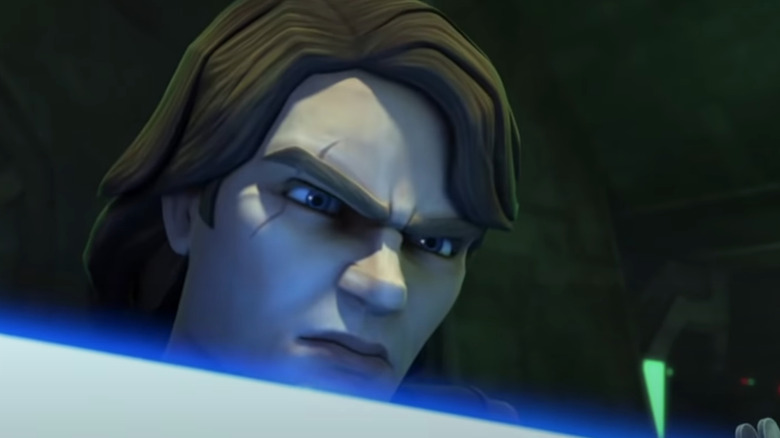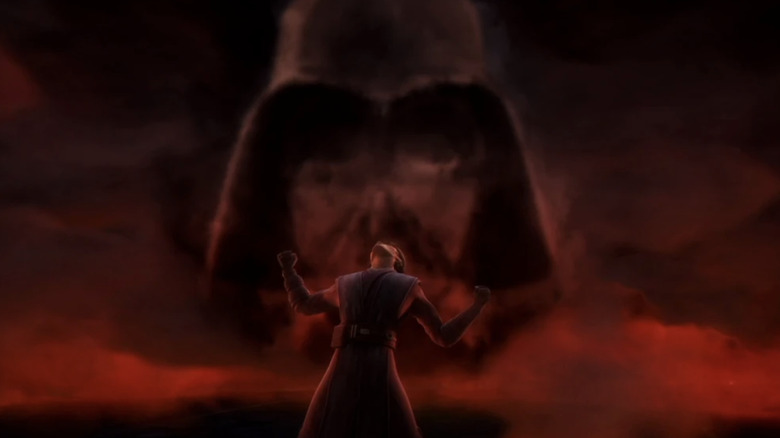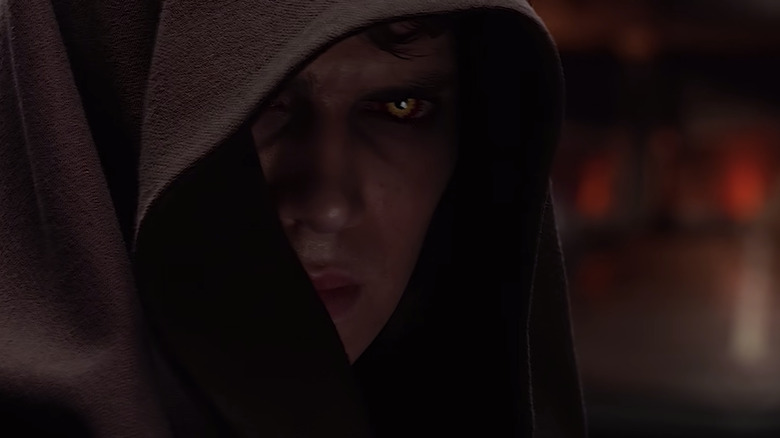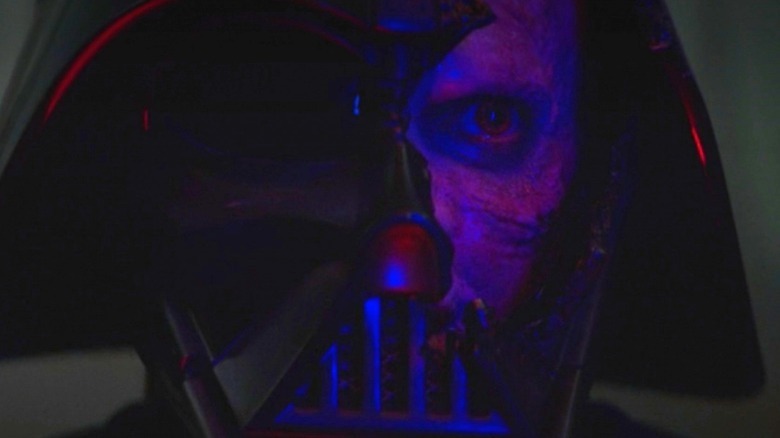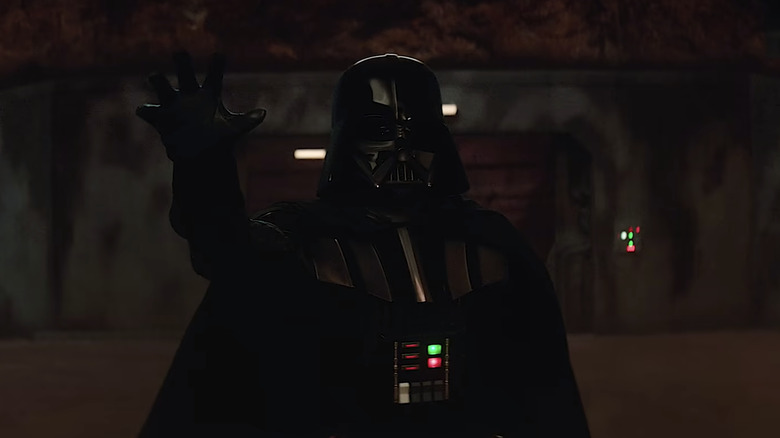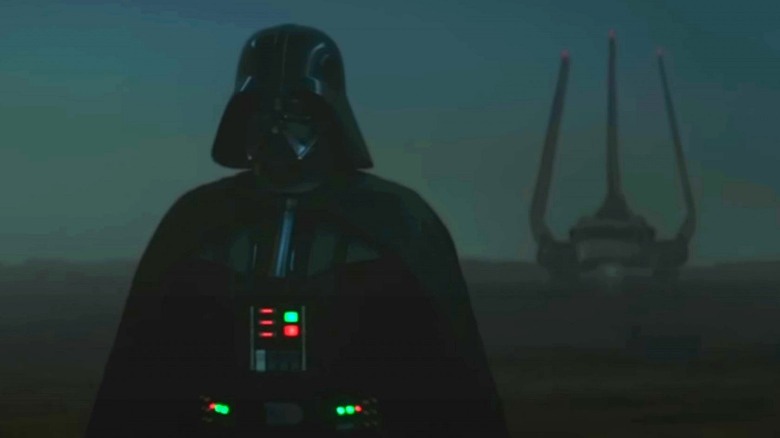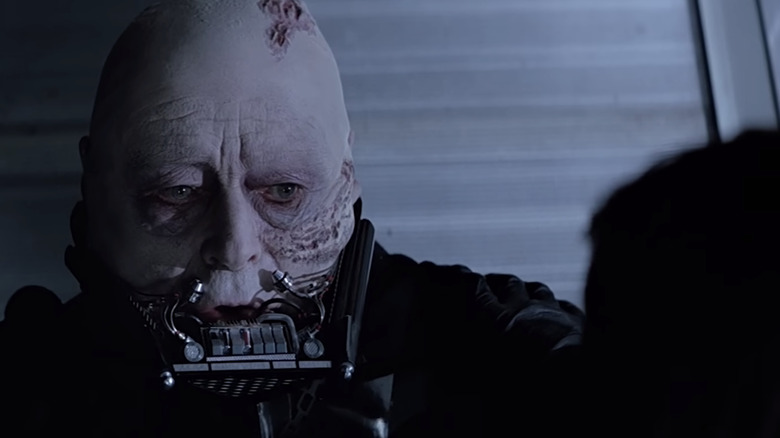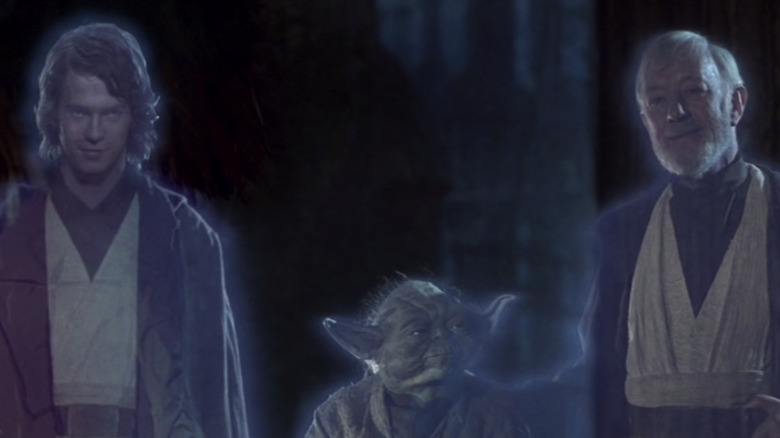How Powerful Is Darth Vader Actually?
Since the first "Star Wars" premiered in theaters back in 1977, fans have cowered at the sight of one of cinema's all-time greatest villains: Darth Vader. The Dark Lord of the Sith held an invisible grasp on those around him and threatened to destroy entire planets if it meant keeping the Empire together. There's no doubt that, although he wasn't at the very top of the Empire's food chain, he was the scariest enforcer the Emperor ever had. Years later, George Lucas would expand on Vader's previous life as a Jedi named Anakin Skywalker, both in the prequel trilogy of "Star Wars" films as well as "The Clone Wars" animated series, giving us a fully-rounded picture of whom exactly this Lord Vader is and where he came from.
But in all of the Darth Vader-themed excitement, something hasn't sat quite right with every "Star Wars" fan ... just how powerful is he exactly? Some of the Marvel Comics and animated shows, such as "Star Wars Rebels," show Vader as being incredibly powerful at some times, and at other times he holds the same power set as in the original trilogy. In "Obi-Wan Kenobi," we see him stop a starship from taking off into space, but in "Rogue One," Vader simply lets the Rebels escape with the Death Star plans. What gives? Well, here, we hope to answer one of "Star Wars" most debated questions: Just how powerful is Darth Vader actually? The answer may surprise you!
Child prodigy
Early on, young Anakin Skywalker (Jake Lloyd) was a Force-sensitive prodigy, long before he was even discovered by Qui-Gon Jinn (Liam Neeson) on Tatooine. Born to a single mother (Pernilla August) with seemingly no father, Anakin grew up fast as a slave serving Watto (Andy Secombe), a local junk dealer. Young Ani was instinctively good with machines, even building his own protocol droid known as C-3PO (Anthony Daniels); he is also known locally as the "only human" who can podrace without dying. It's clear that his connection to the Force — the very life-giving energy that surrounds all living things in "Star Wars" and the supposed origin of Anakin's immaculate conception — is stronger than just about anyone's, with a midi-chlorian count of over 20,000 that surpassed even Yoda. Though despite this, the boy lacked the proper training.
When Qui-Gon discovered Anakin, he vowed to train him, recognizing the boy to be the fulfillment of an ancient prophecy that foretold of a Jedi who would bring balance to the Force, ending the threat of the Sith. Presumably because of his Chosen One status, Anakin was also a natural star-pilot ("the best in the galaxy"), and one who can turn even the worst mistake, like crash-landing into a Separatist hanger in "Star Wars: Episode I — The Phantom Menace," into the best outcome, like deactivating the entire droid army. Although Anakin was incredibly skilled, it's worth noting that the boy had no training and thus struggled to use these abilities as a child in ways he would soon master going forward.
A quick learner
For 10 years, Obi-Wan Kenobi (Ewan McGregor) trained Anakin Skywalker (now Hayden Christensen) in the ways of the Jedi, teaching him invaluable lessons of balance and lightsaber technique. Due to Obi-Wan's training and constant support, the young Skywalker grew incredibly skilled with the Force, willing to perform life-endangering feats if it meant bringing villains to justice. This could be seen clearly in "Star Wars: Episode II — Attack of the Clones," when Anakin jumped out of a speeder on Coruscant only to land on the bounty hunter Zam Wesell's (Leeanna Walsman) speeder without any real harm. Anakin was so in tune with the Force that he could sense danger from miles, and sometimes even entire planets, away. Because of these feats, Anakin quickly became one of the most notable Jedi in the entire Order.
During the Clone Wars, Anakin (voiced by Matt Lanter) was promoted to a Jedi Knight and given his own apprentice named Ahsoka Tano (voiced by Ashley Eckstein). Anakin's own stubbornness and quick-to-action strategies were quickly inherited by his padawan, who only grew more powerful herself (thanks to Anakin's teaching). For years, Anakin fought alongside his master, his apprentice, and the Clones against the Separatists and their droid armies, dueling with the most dangerous criminals in the galaxy, such as the Sith Lord Count Dooku (voiced by Corey Burton), Darth Maul (voiced by Sam Witwer), and General Grievous (voiced by Matthew Wood) among others, winning various battles and saving countless lives. Anakin would often save his master from harm's way and, due to his heroic prowess, he'd eventually be known as the "Hero With No Fear" by wartime propagandists.
A battle-hardened Jedi
Years went by, and Anakin Skywalker only became a better Jedi. Though there were moments of darkness that he would experience throughout the Clone Wars, Anakin ultimately served the Jedi well. His potential, and the scope of his abilities, were only highlighted further with each new battle and every challenge that awaited him. Perhaps one of Anakin's strongest suits was his skill with a lightsaber, preferring the fifth form of lightsaber technique, which emphasizes strong counter-attacks with the goal of saber-to-saber combat. While it took him years to view the weapon as his "lifeline," Anakin's swordsmanship and form were excellent. As a padawan, he even took on Count Dooku (Christopher Lee) single-handedly with two saber blades, though he lost a hand in the duel.
In his final encounter with Dooku in "Star Wars: Episode III — Revenge of the Sith," Anakin overpowered the Sith Lord before — against his better judgment — being talked into killing the Separatist leader by Supreme Chancellor Palpatine (Ian McDiarmid), who desired Anakin's fall to the Dark Side. This premeditated murder strengthened Anakin's connection to the Dark Side so that by the time he defected from the Jedi, he was immensely more powerful than most Sith apprentices. As far as raw power was concerned, there was no one stronger, and Anakin would prove that time and again as one of the prominent Jedi Knights in the Order, one who would be made a part of the Jedi Council even before he was officially a Jedi Master — though this irked Skywalker to no end.
Lust for power
Throughout his time as a Jedi, especially during the Clone Wars, Anakin Skywalker continually felt the need to prove himself. Whether it was his own personal insecurities about his role as the Chosen One or his desire to be the "most powerful Jedi" there is, he always believed he could be better. Unfortunately, Anakin's lust for power only took him down darker paths, and in moments such as his slaughter of Tusken Raiders after his mother's death and later, his murder of Count Dooku, he tasted what that power could bring. At one point during "The Clone Wars," he even saw a vision of his eventual fate, a vision he would tragically forget. It was these small steps towards darkness that would prepare Anakin for his role as Darth Vader.
Unlike emotionally balanced Jedi such as Obi-Wan, Yoda (Frank Oz), or even Ahsoka, Anakin was prone to fits of anger and rage that — for a time — strengthened the scope of his abilities. This was seen a few times when Anakin used Dark Side powers such as Force choke with ease long before he actually defected to the Sith. Unfortunately, it also left him open to weakness, as he was slowly seduced by Palpatine and his empty promises. Although Obi-Wan and Ahsoka anchored Anakin to the Light Side of the Force, even they weren't strong enough to keep him there forever. Eventually, the young Skywalker, left alone, let another emotion get the best of him: fear.
Fear to anger
Anakin Skywalker spent so much time training his body for battle that he rarely spent time training his mind. This weakness would prove devastating as he left his mind open to attack from overwhelming thoughts of fear and failure, including prophetic dreams of his wife, Padmé (Natalie Portman), dying in childbirth. While these prophetic dreams only showed how strong Anakin's connection to the Force truly was — prophetic dreams were a rare gift, even among Jedi — they unfortunately crippled him with fear and serious doubts about his alleigance. Palpatine preyed on these fears, ultimately convincing Anakin to betray the Jedi Order and join him as Darth Vader.
Ashamed of his choices and angry that those closest to him — namely Obi-Wan and Padmé — Anakin attacked his former allies, but only after slaughtering those left at the Jedi Temple. Overpowering Mace Windu (Samuel L. Jackson), a high-ranking Jedi Council member and lightsaber master himself, and those at the Jedi Temple only proved how strong in the Force the young Skywalker truly was, and his new Dark Side abilities dialed that up to 11. Killing younglings, padawans, and even Council members with ease was just the rush of power Anakin needed to become Darth Vader. Of course, this was only made possible once Palpatine harnessed Anakin's fear and rage into something that the new Sith Lord's own wife would soon not recognize, breaking her heart and ultimately killing her.
Revenge is a powerful motivator
With each Jedi life he took, Darth Vader grew stronger. Completely divorcing his former morality from his current actions, Anakin Skywalker severed his conscience in a way very few ever could. Thus, when Anakin met Obi-Wan on the volcanic battlefield of Mustafar, their skills were equally matched. Obi-Wan represented Anakin's last tether to the Light, while Anakin-now-Vader represented the Sith, fully embracing the Dark Side. Had Vader not lost this battle, he might've grown to become an even more powerful Sith Lord than he already would — possibly the most powerful Sith of all. But ultimately, Anakin's own unchecked anger was his undoing, with multiple limbs and burning flesh being the harsh consequences of his own pigheadedness.
However, revenge is a powerful motivator. It was this that drove Vader to hold onto his life and, eventually, to hunt down Obi-Wan in "Obi-Wan Kenobi" and Ahsoka in "Star Wars Rebels." This rage that Vader specifically felt towards his former master even gave him the strength to stop an entire spacecraft mid-takeoff, throwing it back to the ground and ripping it apart in search of the Jedi. In his second duel with Kenobi, Vader almost won, but rather than finish off his former master, his own arrogance got in the way, reminding Obi-Wan that he chose his life as a Sith. Years later, in "Star Wars: Episode IV — A New Hope," Vader (voiced by James Earl Jones) would finally kill Kenobi (played by Alec Guinness) in battle, though only because Obi-Wan allowed it so that he might help Luke (Mark Hamill) defeat the Empire, and Vader, later on.
Rage against the machine
Throughout "Star Wars" canon, Darth Vader has done some incredible things with the Force. In the comics, he destroys a dam that floods an entire city, killing millions, and in "Star Wars Rebels," he impossibly survives the destruction of a Sith Temple. Yet sometimes Vader seems pretty selective with his power. Why doesn't he stop the Millennium Falcon from leaving Hoth in "Star Wars: Episode V — The Empire Strikes Back," or why doesn't he stop Leia's (Carrie Fisher) ship in "Rogue One: A Star Wars Story" when the Rebels escape with the Death Star plans? For many, these questions prove to be major plot holes in established canon, especially given his seeming power boost in "Obi-Wan Kenobi."
The truth is, to tap into the power of the Dark Side, one must give in completely to their emotions, and in Vader's case, that emotion is often some sort of anger or rage. While he can still use basic Force abilities regardless (as a result of his prior training), in the case of something like stopping blaster bolts or a spacecraft mid-air, an intense amount of rage must be felt, almost like a burst. In "Obi-Wan Kenobi," Vader's hatred for his former master allows him to stop the spacecraft from taking off, but once that burst of rage is over, his power gauge essentially resets. In "The Empire Strikes Back" and "Rogue One," Vader simply didn't have that same desire for revenge to pull from, making his burst of power in "Obi-Wan Kenobi" both exciting and unique.
Robotic limitations
Although Darth Vader was further enhanced by his new robotic limbs and the suit that controlled it all (including his trademark breathing apparatus), it wasn't always what it was cracked up to be. The suit gave Vader enhanced physical strength and a healthy amount of stamina — good things to be sure; Anakin Skywalker's broken body could not survive without it. Left alone, he would have eventually died, but with his new enhancements, Vader could focus on his connection to the Dark Side rather than forcing himself to keep breathing. But being more machine than man came with its own downsides and challenges as well.
Though Vader's connection to the Dark Side was still strong, his robotic limbs left him with some serious power disadvantages. For one, although he could rebuild himself if need be, he was forced to retrain himself to fight without being able to feel his limbs. But more importantly, Darth Vader would never be able to learn the Sith lightning powers that Palpatine used to kill Mace Windu. In fact, the lightning itself would fry Vader's cybernetics, and would eventually be the cause of his death at the end of "Star Wars: Episode VI — Return of the Jedi." This weakness severely limited the powers Vader could eventually possess, as well as his ability to overthrow the Emperor. This is why he would ask both his former apprentice Ahsoka Tano and his own son Luke Skywalker to join him in ruling the galaxy. He couldn't do it alone.
Children soften you up
Another untimely weakness that would limit the scope of Darth Vader's power was the discovery that he in fact had a son: Luke Skywalker. After learning this, all bets were off for Vader, who quickly sought out the boy to use against the Emperor. Between "Episode IV" and "Episode V," Vader would hunt for the younger Skywalker and almost capture him, though the emotional connection he'd feel toward his son would prevent him from killing the boy in battle — Vader even crashed his TIE Fighter rather than risk killing Luke in the "Vader Down" crossover. Of course, he'd have no problem cutting off his son's hand in "The Empire Strikes Back," though it's worth noting that, even after this, he allowed Luke to escape, either unable to stop him or unwilling to.
It's Vader's children who reintroduced him to the Light Side of the Force, allowing him to rectify his mistakes over the past 20-something years and finally usurp the Emperor. Though Vader fought the Light, he eventually embraced it after seeing Luke tormented by his evil master. The love that Vader had for his children, and for Padmé, overpowered all his anger and rage, giving him the final burst of strength he needed to toss Palpatine down to his demise. Although this self-sacrificing act was ultimately what killed him, Anakin Skywalker reclaimed his role as the Chosen One and finally brought balance to the Force, a feat that he could only accomplish with Luke's help.
Good always prevails
Though Anakin Skywalker only returned to the Light Side of the Force in his final moments, this selfless act proved enough for Obi-Wan Kenobi and Yoda to restore their former friend as a Force ghost, one who would gain "more power than [he] could ever imagine." While not much is known about Anakin's time as a Force ghost (not much that's still canon anyway), we do know that he would eventually — along with countless other Jedi — come to the aid of Rey (Daisy Ridley) nearly 30 years later in "Star Wars: Episode IX — The Rise of Skywalker," when she finally ended the threat of Emperor Palpatine once and for all. Without the strength of the Chosen One by her side, it might've been impossible for her — and Anakin's grandson, Ben Solo (Adam Driver) — to defeat the Sith Lord.
According to Obi-Wan, becoming a Force ghost — which is something only those who serve the Light Side of the Force may do — makes one even more powerful than they were in life. In "Star Wars: Episode VIII — The Last Jedi," Yoda's Force spirit is seen using a form of Force lightning, while Kenobi's Force ghost often spoke to Luke before he was even ready to see him. While it seems like there are countless other abilities that are possible for deceased Jedi, we have yet to see Anakin's Force ghost beyond the final moments of "Return of the Jedi," although it seems terribly likely that he too now has powers beyond what we could ever imagine.
